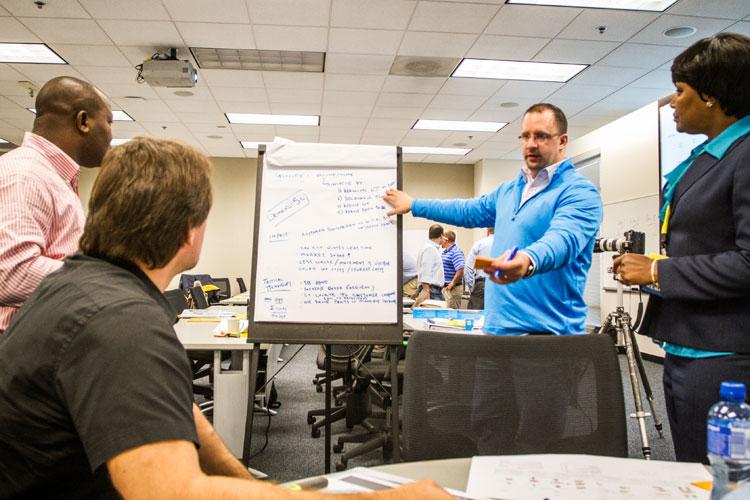Supply Chain Risk and Resilience
- Overview
- Course Content
- Requirements & Materials
Supply Chain Risk and Resilience
Course Description
This course provides a practical, streamlined approach to building organizational resilience to disruptions. In our hyper-connected world, disruption is the new normal. Businesses face a relentless onslaught of risks – from supply chain breakdowns to cyber attacks and market shifts. Yet too many organizations rely on little more than hope when it comes to managing these threats. Course participants will discover how to leverage both classic risk management tools and cutting-edge technologies to proactively identify, assess, and mitigate a wide range of risks. Learn how to embed resilience planning into your regular business processes, so you are prepared for the unexpected.
Module 1: Understanding Supply Chain Risk
- Content: Types of risks (operational, financial, environmental, geopolitical, and cybersecurity) and their impact on business continuity and customer satisfaction
- Key Takeaways: Frameworks for identifying and categorizing risks within an organization’s supply chain, including upstream and downstream risks
Module 2: Building a Risk Assessment Framework
- Content: Methods for assessing risk, including failure mode and effect analysis (FMEA), risk matrices, and vulnerability mapping
- Key Takeaways: Tools and templates to prioritize risks based on likelihood, impact, and mitigation difficulty
Module 3: Developing Resilience Strategies
- Content: Strategies for resilience, such as diversification, redundancy, supplier risk management, and disaster recovery
- Key Takeaways: Actionable techniques to build flexibility into supply chains, reduce dependency on single suppliers, and prepare for disruptions
Module 4: Embedding Resilience in Company Culture and Governance
- Content: Importance of leadership, communication, and training in maintaining a resilient supply chain
- Key Takeaways: How to champion resilience in organizational culture, establishing governance frameworks to sustain risk management efforts
Module 5: Scenario Planning and Stress Testing
- Content: Designing scenario-based exercises (e.g., what-if analyses) to test supply chain resilience
- Key Takeaways: Practical approaches to anticipate disruptions, identify response weaknesses, and refine recovery plans
Module 6: Case Studies and Real-World Applications
- Content: Review of case studies illustrating successful and unsuccessful responses to major supply chain disruptions
- Key Takeaways: Approaches taken by leading companies with practical takeaways that can be applied to participants' organizations
Module 7: Technology and Tools for Risk Management
- Content: Overview of digital tools like predictive analytics, Internet of Things (IoT) for real-time monitoring, AI for demand forecasting, and supply chain risk management software
- Key Takeaways: How to leverage technology for proactive risk identification, real-time monitoring, and scenario planning
Module 8: Developing an Action Plan for Resilience
- Content: Guided workshop to develop a customized risk and resilience action plan
- Key Takeaways: Outline of actionable steps for implementing upon returning to work that focus on high-priority risks and resilience measures
Prerequisites
Some operational experience in logistics planning along with a basic level of understanding of your company's supply chain network are recommended.
Session Details
Special Discounts: All residents of the State of Georgia are eligible for a 50% discount while funds last thanks to a grant from the U.S. Department of Commerce's Economic Development Administration. Use of this discount is subject to verification of GA residency. Enter coupon code SCL-GAAIM at checkout (cannot be combined with other discounts).
Non-Georgia residents can register and pay for all required courses in a Supply Chain & Logistics certificate and receive a discount of 17% off per course. Enter coupon code SCL-Cert at checkout. Review coupon instructions for more information.
If you have 3 or more participants from your organization, please contact us for volume discounts at course@scl.gatech.edu.
CRN
25509CRN
25508Who Should Attend
This course is ideal for supply chain planning professionals, risk management and identification specialists, industry and government officials who are responsible for critical infrastructure, and business leaders in any sector concerned with potential operational disruptions.

What You Will Learn
- Basics of supply chain risk identification and mitigation strategies
- Ways to make supply chains more resilient and adaptable using leading-edge thinking
- Processes for building comprehensive risk management and resilience plans that integrate seamlessly into annual planning and ongoing business operations
- Conceptual frameworks as well as practical tools and techniques for dealing with supply chain disruptions

How You Will Benefit
- Discover frameworks and methodologies for proactively mapping your organization's supply chain risk profile.
- Leverage data analytics, AI, and other technologies to enhance risk visibility.
- Learn strategies for designing flexible, adaptable response plans that can be stress-tested and refined over time.
- Practice creating detailed action plans for mitigating the impact of potential risks within your company and industry.
- Develop a structured approach to disruption management, from initial incident response to restoring normal operations.
- Gain knowledge and confidence in making resilience a core part of your organization's DNA, not just a siloed risk management exercise.
-
Grow Your Professional Network
-
Taught by Experts in the Field
Related Programs















The Georgia Tech Global Learning Center and Georgia Tech-Savannah campus is compliant under the Americans with Disabilities Act. Any individual who requires accommodation for participation in any course offered by GTPE should contact us prior to the start of the course.
Courses that are part of certificate programs include a required assessment. Passing criteria is determined by the instructor and is provided to learners at the start of the course.
CEUs are awarded to participants who attend a minimum of 80% of the scheduled class time.
Georgia Tech’s Office of Research Security and Compliance requires citizenship information be maintained for those participating in most GTPE courses. Citizenship information is obtained directly from the learner at the time of registration and is maintained in the Georgia Tech Student System.
Learners enrolled in any of Georgia Tech Professional Education's programs are considered members of the Georgia Tech community and are expected to comply with all policies and procedures put forth by the Institute, including the Student Code of Conduct and Academic Honor Code.
Please refer to our Terms and Conditions for complete details on the policies for course changes and cancellations.
Participants in GTPE courses are required to complete an online profile that meets the requirements of Georgia Tech Research Security. Information collected is maintained in the Georgia Tech Student System. The following data elements are considered directory information and are collected from each participant as part of the registration and profile setup process:
- Full legal name
- Email address
- Shipping address
- Company name
This data is not published in Georgia Tech’s online directory system and therefore is not currently available to the general public. Learner information is used only as described in our Privacy Policy. GTPE data is not sold or provided to external entities.
Sensitive Data
The following data elements, if in the Georgia Tech Student Systems, are considered sensitive information and are only available to Georgia Tech employees with a business need-to-know:
- Georgia Tech ID
- Date of birth
- Citizenship
- Gender
- Ethnicity
- Religious preferences
- Social security numbers
- Registration information
- Class schedules
- Attendance records
- Academic history
At any time, you can remove your consent to marketing emails as well as request to delete your personal data. Visit our GTPE EU GDPR page for more information.
Classes and events being held at the Georgia Tech Global Learning Center in Atlanta or Georgia Tech-Savannah campus may be impacted by closures or delays due to inclement weather.
The Georgia Tech Global Learning Center will follow the guidelines of Georgia Tech main campus in Atlanta. Students, guests, and instructors should check the Georgia Tech homepage for information regarding university closings or delayed openings due to inclement weather. Please be advised that if campus is closed for any reasons, all classroom courses are also canceled.
Students, guests, and instructors attending classes and events at Georgia Tech-Savannah should check the Georgia Tech-Savannah homepage for information regarding closings or delayed openings due to inclement weather.
GTPE certificates of program completion consist of a prescribed number of required and elective courses offered and completed at Georgia Tech within a consecutive six-year period. Exceptions, such as requests for substitutions or credit for prior education, can be requested through the petition form. Exceptions cannot be guaranteed.
Please refer to our Terms and Conditions for complete details on the policy for refunds.
Georgia Tech is a tobacco-free and smoke-free campus. The use of cigarettes, cigars, pipes, all forms of smokeless tobacco, and any other smoking devices that use tobacco are strictly prohibited. There are no designated smoking areas on campus.
Courses that are eligible for special discounts will be noted accordingly on the course page. Only one coupon code can be entered during the checkout process and cannot be redeemed after checkout is complete. If you have already registered and forgot to use your coupon code, you can request an eligible refund. GTPE will cancel any transaction where a coupon was misused or ineligible. If you are unsure if you can use your coupon code, please check with the course administrator.
GTPE does not have a program for senior citizens. However, Georgia Tech offers a 62 or Older Program for Georgia residents who are 62 or older and are interested in taking for credit courses. This program does not pay for noncredit professional education courses. Visit the Georgia Tech Undergraduate Admissions page for more information on the undergraduate program and Georgia Tech Graduate Admissions page for more information on the graduate program.
Most GTPE classroom courses are held at the Georgia Tech Global Learning Center (GLC). Any courses that are held elsewhere will be clearly marked on the course page. Get information on parking, directions, and transportation to the GLC.
We do not provide overnight rooms. However, accommodations can be made at the Georgia Tech Hotel and Conference Center, adjacent to us. Additional hotels can be found within walking distance. Get more information on accommodations.
Learners may transfer to another course of equal or greater cost if notification is made at least 10 business days prior to the original course start date. The course to which one transfers must already be scheduled.
We recommend you register for courses as early as possible. Session details will indicate when there is less than five remaining seats in a particular session.
Updates to your company, address, email, phone, and passwords can be made directly on the GTPE website. Name changes and citizenship changes must be submitted to the GTPE Registrar’s Office.
- Complete a GTPE profile.
- Shop for a course.
- Add the course(s) to the cart.*
- Apply a special discount code (if applicable).
- Provide an accepted payment method to complete the order (credit card, third party credit card holder, or one accepted payment document).
*Carts will remain active for 14 days, but seats are not held until the transaction is complete.
Walk-in registrations are accepted based on space availability but are not guaranteed for any courses.
If available, discounts will display on the course page or will be automatically applied during the purchase process. Only one coupon code should be entered during the checkout process and will be validated by the system if applicable to items in your cart. If you have already registered and forgot to use your coupon code, you can request an eligible refund.
GTPE does not have a discount program for senior citizens. However, Georgia Tech offers a 62 or Older Program for Georgia residents who are 62 or older and are interested in taking for credit courses. This program does not pay for noncredit professional education courses. Visit the Georgia Tech Undergraduate Admissions page for more information on the undergraduate program and the Georgia Tech Graduate Admissions page for more information on the graduate program.
GTPE does not have a program for senior citizens. However, Georgia Tech offers a 62 or Older Program for Georgia residents who are 62 or older and are interested in taking for credit courses. This program does not pay for noncredit professional education courses. Visit the Georgia Tech Undergraduate Admissions page for more information on the undergraduate program and the Georgia Tech Graduate Admissions page for more information on the graduate program.
In the event of a cancellation, we will provide you with a full refund or transfer to an equivalent course.
Short courses (1-5 days) and conferences do not require a student visa. A B-2 Tourist Visa, along with a copy of your registration confirmation email and a copy of your completed web registration order page, should suffice.
If participation in a course is employment related, with immediate departure from the U.S., then a B-1 Temporary Business Visa will be required.
We encourage you to contact your U.S. Consulate or Embassy to determine visa eligibility. Full refunds will be provided to participants who are unable to obtain an entry visa and contact our office prior to the start of the course.
English as a Second Language students should contact the Language Institute for admission and visa requirements.
We do not issue letters of invitation and cannot provide immigration documents for the issuance of a student visa. Full refunds will be provided to participants who are unable to obtain an entry visa and contact our office prior to the start of the course.
If you need assistance with your group registration or have questions on how to start the process, please feel free to contact us at 404-385-3501 or peregistration@gatech.edu.
There is no special process or form to register your group. All interested learners must create and manage their own individual profiles, accounts, and registrations.
- Complete a GTPE profile.
- Shop for a course.
- Add the course(s) to the cart.*
- Apply a group discount code (if applicable).
- Provide an accepted payment method to complete the order (credit card, third party credit card holder, or one accepted payment document).
*Carts will remain active for 14 days, but seats are not held until the transaction is complete.
Courses that offer group discounts will display the discount code on the course page. Your employees will use the code during the registration process and cart totals will adjust accordingly. Group discounts can only be used if three or more employees from the company attend the same course and only one coupon code can be use per shopping cart.
If you have already registered and forgot to use your coupon code, you can request an eligible refund.
Accepted payment documents must be uploaded during the registration process. They include:
- A company purchase order (PO or SF182)
- A letter of authorization on company letterhead
- A corporate education application/voucher
- Name of company and physical address
- Name of employee(s) approved for training
- Document number (SF-182 documents: Section C, Box 4)
- Billing address (SF-182 documents: Section C, Box 6)
- Course title and course dates
- Maximum disbursement amount (billing amount)
- Expiration date (if applicable)
- Authorized signature(s)
- Payment terms less than or equal to net 30
The employee can print of a copy of their shopping cart to submit if required for payment documents. The cart will remain active for 14 days, but the seat will not held until registration and payment is complete.
Registrations cannot be processed without payment. If your employee is concerned about losing a seat in a class because of internal company processes, we suggest that they go ahead and register and pay with a personal or corporate credit card and seek reimbursement.
If you need assistance with your group registration or have questions on how to start the process, please feel free to contact us at 404-385-3501 or peregistration@gatech.edu.
GTPE’s use of CEU follows accepted criteria and guidelines established by the Georgia Board of Regents which follows international standards such as The International Association for Continuing Education and Training (IACET).
GTPE does not issue transcripts or certificates with Professional Develop Hours (PDH) or Professional Development Units (PDU), but the crosswalk here is provided for reference.
One CEU = 10 contact hours of instruction
One PDH = 1 contact hour of instruction (one CEU = 10 PDH)
One PDU = 1 contact hour of instruction (one CEU = 10 PDU)
Upon successful completion of most GTPE courses (80% minimum attendance and a passing grade in courses that require an assessment), you may receive a certificate indicating the number of CEUs earned. Certificate issuance exceptions include courses with outstanding credentialing entities (i.e. OSHA or PADI).
CEUs earned are recorded in the attendee’s name and will appear on a GTPE transcript. All transcripts must be requested by the attendee via the transcript request form. Requests are typically processed within three business days.
For an audit of your transcript for progress toward completion of a certificate, please complete the transcript request form. GTPE courses do not provide academic or degree credit. Georgia Tech academic or degree credit is only available to matriculated students taking courses that meet degree requirements.
For specific information on state licensing or credit requirements, please contact your state licensing board. If you are seeking certification through a professional association, please review the specific requirements with that association.
Please see our Terms and Conditions for complete details on our policies for course registration changes.
TRAIN AT YOUR LOCATION
We enable employers to provide specialized, on-location training on their own timetables. Our world-renowned experts can create unique content that meets your employees' specific needs. We also have the ability to deliver courses via web conferencing or on-demand online videos. For 15 or more students, it is more cost-effective for us to come to you.
-
Save Money
-
Flexible Schedule
-
Group Training
-
Customize Content
-
On-Site Training
-
Earn a Certificate